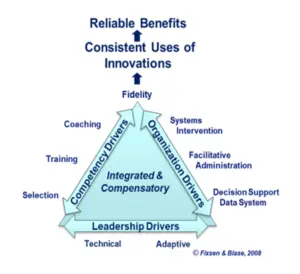Innovations are, by definition, new ways of work. New ways of work are disruptive to practitioners and organizations that must change in modest or radical ways to accommodate and support the high fidelity and effective use of an innovation by practitioners. Competency drivers, organization drivers, and leadership drivers guide the work of implementation in any organization.
The Active Implementation Drivers are based on the commonalities among successfully implemented practices and programs found in the literature and derived from current best practices. Implementation Drivers are the engine of change (Fixsen et al., 2005). Drivers are dynamic and interact in interesting ways to produce consistent uses of innovations and reliable outcomes for students and others. Implementation Drivers have been categorized as Competency, Organization, and Leadership supports.
Effective innovations are, by definition, new ways of work and require behavior change. For competency development, new ways of work need to be taught and learned through training and coaching with practitioners (nurses, organization staff, implementation team members) who have been selected (mutual selection for individuals is similar to the Exploration Stage for organizations) to be the first to use the innovation. As coaches support practitioners in learning the innovation and as performance (fidelity) assessments are used to monitor the progress of teaching and learning, organization and system facilitators and barriers are identified and overcome.
Organization supports are developed by facilitative administrators (managers, directors) who change organization practices and support systems interventions so they can establish a hospitable environment for the use of effective innovations and the use of effective implementation supports for practitioners. Having a decision support data system is an essential component for guiding the processes of establishing the innovation and the implementation supports for practitioners, and for assessing immediate outcomes. For example, data may show low fidelity performance for a group of practitioners being coached by a given individual while other practitioners routinely are meeting performance criteria. These data might support a decision to focus on the quality of coaching rather than the effectiveness of an innovation.
Finally, implementation requires leadership that can help resolve adaptive issues (convening groups to identify problems, arriving at consensus regarding how to approach a solution, detecting progress toward resolution) and technical problems (setting goals, managing time and effort, solving problems of known dimensions) that arise in the course of initiating changes in the ways of work and managing change in organizations and systems.
These interactive processes are integrated to maximize their influence on staff behavior and the organizational culture. The interactive implementation drivers also compensate for one another so that a weakness in one component can be overcome by strengths in other components. These core implementation components (implementation drivers) are shown in the figure below.
Download: StaffSelectionProcess
Download: ImplementationSpecialistPositionAndInterview
Download: AIRN-AiPracticeProfile
Download: AssessingDriversBestPractices

